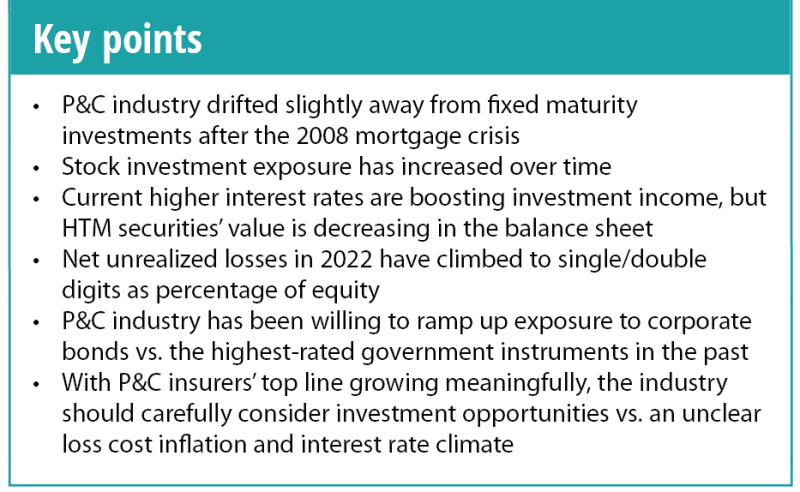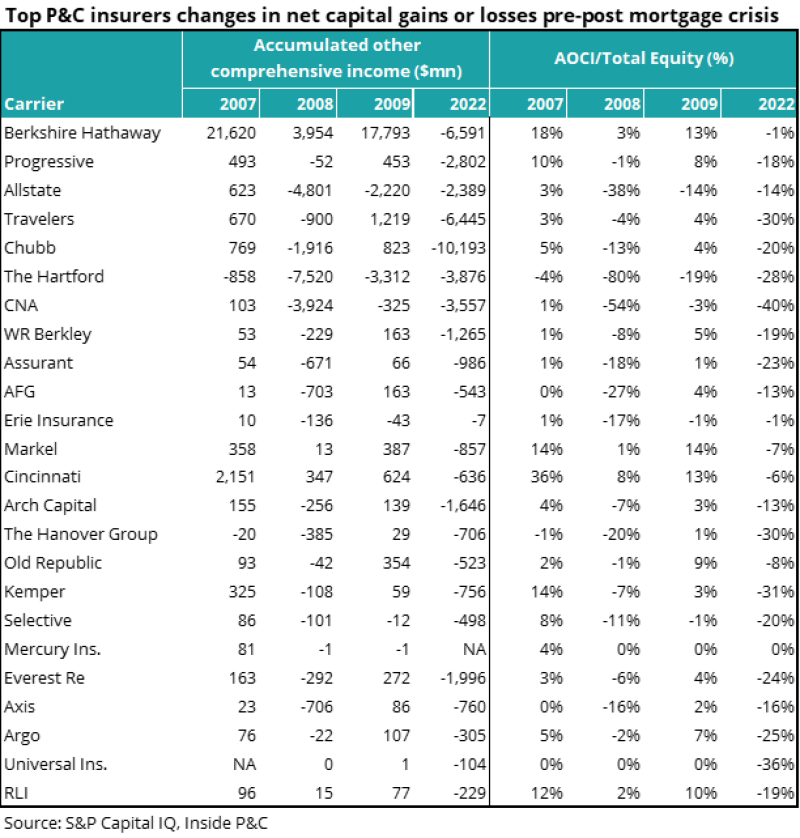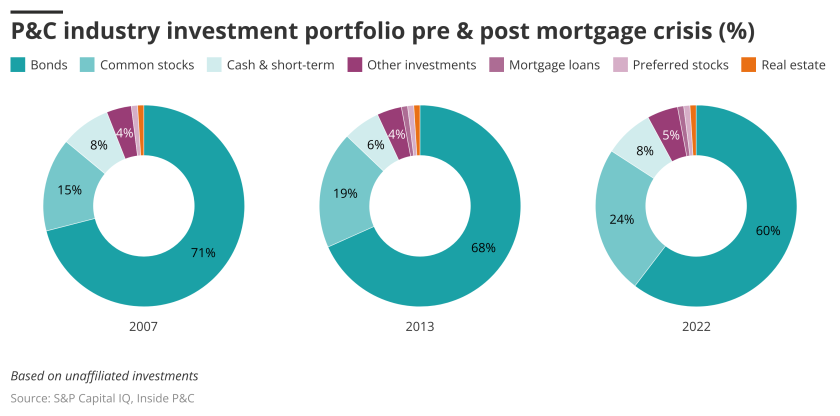The 2008 mortgage crisis was another reality check for the industry, where the problem was more about valuing asset classes than the loosening of investment standards. Even then, insurance companies knew that unrealized losses created fears around liquidity, capital adequacy, solvency and appropriate amounts of investment leverage.
Fast forward to 2021/22/23 and, due to the impact on carrying values on invested assets, we are revisiting how investment portfolios have evolved over the past 15 years or so.
Firstly, P&C industry fixed-income exposure reduced since the mortgage crisis.
The 2008 mortgage crisis was partially a banking crisis, but we also saw insurance companies being affected by direct exposure to the US real estate market and related fixed-income securities like residential mortgage-backed securities (RMBS) and commercial mortgage-backed securities (CMBS).
It visibly impacted the P&C insurance industry’s investment portfolios. We have analyzed the P&C investment portfolio mix before and after the crisis and compared it to investment strategies in more recent periods.

As shown in the chart below, during 2007-09, the US P&C industry had around 71% to 74% of total investments in fixed-income securities, and 11% to 15% in common stocks, then post-crisis, we see a gradual shift from fixed-income securities towards common stocks.
Many insurers backed away from the bond market by diversifying into other less liquid assets, primarily due to the low-yield decade that followed the 2008 mortgage crisis, when insurers were willing to remain in cash or shorter-duration instruments.
As of December 31, 2022, the US P&C industry had 60% in fixed-income securities and 24% in common stocks. The outbreak of Covid and high inflation adds further pressure on credit and the market risk environment.
Notice that in 2021 investment in bonds was at its lowest proportion, coinciding with the end of a lengthy period of low interest rates. As interest rates rose sharply in 2022, we see the proportion of bonds grow back to 60% as higher yields become attractive again.
Secondly, unrealized losses for 2022 are reminiscent of the mortgage crisis but underlying factors differ.
As discussed, the insurance industry always welcomes modestly increasing interest rates. But the continuous increase in Fed funds rates also reduces the market value of existing bonds on their balance sheets.
To better understand unrealized losses, during the financial crisis and in 2022, we analyzed accumulated other comprehensive income (AOCI) at the top 25 P&C insurers. We can see a significant increase in unrealized losses on fixed-income portfolios as rising interest rates diminish bond values.
Comparing the % impact to equity for 2022 vs 2008 a cursory look reveals a similar proportion for many players. However, the underlying reasons are quite different. In 2008, the negative marks to book value apart from the broader meltdown in the market were also due to revisiting how many of the instruments were valued. In 2022, the marks are due to interest rate change in a year which was one of the highest on an annual basis. Since insurers hold these to maturity these marks will continue to reverse over time. We have already seen some of this reversal play out as witnessed in Travelers’ Q1 earnings report.

In terms of structured securities, the P&C industry’s exposure to mortgage loans has remained stable since the financial crisis, at around 5% of total unaffiliated investments. But, within MBS, we saw a clear trend of increasing exposure in RMBS post-financial crisis, a drift away from CMBS.
During 2007-09, the industry had nearly 38% to 42% of total mortgage-backed securities in RMBS, which increased to 50% to 64% between 2011 and 2015.
The current mix of mortgage-backed securities stands at 40% in RMBS, 25% in CMBS and the rest in other loan-backed and structured securities in 2022.
Thirdly, as industry capital has remained stable, insurers are willing to look beyond Class 1 bonds.
The trend shows that P&C insurers are willing to move along the risk/reward matrix. The concentration of Class 1 bonds appears to have decreased steadily for the past 15 years. This is likely due to a long period of near-zero interest rates where these instruments will typically have the lowest returns.
Class 1 bonds with AAA to A- ratings by top three rating agencies (Moody’s, S&P and Fitch) reduced significantly in 2022.
Low interest rates had led to a shift towards corporate bonds and away from government-issued fixed-income securities.
The P&C industry held nearly 88% to 92% Class 1 bonds during 2007 to 2009, which has reduced to 77% between 2020 and 2022.
In summary, insurers, over time, are willing to look beyond the tried-and-tested fixed income investment as overall industry capital has remained stable. However, with the future direction of interest rates and loss cost inflation still somewhat unclear, the industry needs to remain vigilant when thinking about asset/liability matching.

